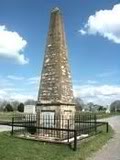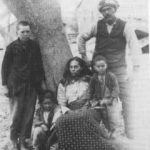Virginia Woman Kidnapped by Shawnee Warriors
Image: Map Showing the Journey of Mary Draper Ingles
The red line shows her movement west as a captive of the Shawnee Indians, and the blue line her return east. The entire trip took place in the summer and autumn of 1755.
Into the Wilderness
Born in 1732, Mary Draper was the daughter of George Draper and Eleanor Hardin, Irish immigrants to Philadelphia. In the 1740s, the Drapers were among the first white settlers to scale the Allegheny Mountains, which were the western edge of colonial exploration and settlement at that time.
They, along with Colonel John Patton, Thomas Ingles and his sons William, Matthew and John settled a natural glade that was well watered by natural springs and streams. The area required much less effort to establish a farm than heavily forested land. The land they chose became known as Draper’s Meadows.
In 1750 at age 18, Mary married William Ingles, and gave birth to two sons, Thomas in 1751 and George in 1753. Living there at that time was Mary’s widowed mother Eleanor, Mary’s brother John Draper, and his wife Elizabeth (Bettie) Robertson Draper and their infant child.
Draper’s Meadows was at that time the westernmost settlement in America. The settlement was built on land that had long been part of traditional Native American hunting grounds, but the settlers maintained a peaceful relationship with the Natives, even providing food and shelter to parties of Indians as they passed by.
During the mid-eighteenth century, many colonists began to move from along the Atlantic seaboard into the mountains and valleys of western Virginia. Native Americans attempted to maintain their private hunting havens from encroachment, but white people continued to flow over the mountain ranges.
The pull and tug between English, French, and natives resulted in the French and Indian War, which involved all of the major European powers of the period, causing 900,000 to 1,400,000 deaths.
The Shawnee Tribe had allied themselves with the French in opposition to the English settlers. Several battles had already been fought to the north in New York and Pennsylvania, but the settlers at Draper’s Meadows knew nothing of these events.
Kidnapped
On July 8, 1755, while Will Ingles was in the fields harvesting wheat, Shawnee warriors swooped down upon Draper’s Meadows in a surprise attack. The war party killed four, wounded two, and took five captives. Mary’s widowed mother Eleanor was scalped in the raid, as was Bettie Draper’s infant child. Colonel James Patton died defending the settlement.
Mary and her two children were captured, along with Mary’s sister-in-law Bettie Draper. Bettie, who suffered a broken arm in the attack. Looting of horses, guns, ammunition, tools, and food occurred before the marauders left. By the time Will realized what was happening, it was too late to save his family, and he barely escaped with his life.
The Indians and their captives traveled for a month to a Shawnee village on the banks of the Scioto and Ohio Rivers, just west of present-day Cincinnati. Mary Ingles cared for her wounded sister-in-law and others over the long trek.
Mary was a strong, resourceful woman, calming her frightened children and foraging for healing herbs along the way. She probably began memorizing landmarks, tying knots into a string to count the days that elapsed, noting the rivers taken.
When they arrived at the Shawnee village, the captives were forced to endure the gauntlet. The Indians formed two long lines and the captives were forced to pass between the rows while their captors flailed them with sticks, clubs, whatever was available. Those who were felled in the passage were forced to start over, while those who endured the passage with bravery and endurance were regarded as fit candidates for Shawnee adoption. Mary was spared this cruel ordeal.
The gauntlet weeded out the unfit, and the survivors were parceled out to the captors. These adoptive Shawnee were replacements for dead Shawnee, and received the worldly goods, title, and prestige that had been held by the deceased. Mary’s sister-in-law Bettie was adopted by a widowed Shawnee and taken to another village, and her sons were traded off.
Escape
Immediately, Mary began plotting her escape. Mary came to the attention of two French traders in the village with several bolts of flannel cloth that, coupled with Mary’s skill as a seamstress, created an opportunity for profit. She started making shirts from the flannel, which considerably enhanced her prestige with the Shawnee. Proud owners of these new flannel shirts were known to parade them through the village.
Among the captives was an elderly German woman from Pennsylvania, whom Mary persuaded to attempt an escape with her. One day in October, Mary and the old woman left the camp, giving the reason as a food gathering expedition. They left a false trail and headed for the Ohio River, equipped with two blankets and a single tomahawk.
They set out on what was nearly a 500-mile trek to southwest Virginia. Avoiding Indian paths for fear of recapture but following the rivers as Mary remembered them, the trip took 43 days. Innumerable setbacks including the onset of winter, pain of exposure, and incessant hunger made the journey horrendous.
Coming Home
In early December, Mary managed to crawl toward the cabin of an old friend, Adam Harmon. The frontier was now on high alert due to Indian hostilities, and Mary was almost shot on her approach, being mistaken for a stealthy Indian.
She had lost her teeth during the ordeal and her formerly luxurious auburn hair had turned completely white at the age of 23. The Harmons took her in, started the long slow process of restoring her to health, and she was soon reunited with her husband, Will.
In the years following Mary’s ordeal, the couple established Ingles’ Ferry across the New River and an inn to service the increasing flow of settlers into the region. The ferry remained in service for almost 200 years.
Will continued in his business ventures and acquired considerable land holdings in the area. Four more children were born to the couple, and Will was able to buy back their captured son Thomas at age 17. The lad was completely integrated into life as an Indian and had trouble acclimating himself back into colonial society. He never lost his respect for the Shawnee, nor his love of their culture.
Will served in the American Revolution and died in 1782 at the age of 53, and Mary never remarried. Her son John built her a ‘proper house’, but she continued to live in the windowless log cabin she had shared with her husband, saying she felt safer there.
Mary Draper Ingles lived to the age of 83, remaining in the couple’s log cabin and operating the ferry until her death in 1815.

Mary Draper Ingles Monument
This monument was erected in 1909 – a 22-foot obelisk stands in the center of West View Cemetery, about a mile and a half from where she lived out her life. The obelisk was constructed of the chimney stones from the original Ingles cabin, and is featured in the book, A Guide to American Women’s Landmarks.
The descendants of Will and Mary Ingles still own and inhabit the land settled by their forebears so long ago. They are a part of the landscape, part of the heritage of endurance exemplified by Mary in her journey.
SOURCES
Rootsweb: Mary Draper Ingles
Wikipedia: Mary Draper Ingles







Thank you for the history of Mary Ingles. I have read the book
Follow The River and found the strength and endurance of Mary to be so inspiring. I had wondered how long she lived after her body enduring so much and this site answered those questions. What an inspiration!!
Thank you for sharing information about Mary Ingles, a woman of tremendous strength, conviction, and endurance. She is an example of great courage. The book, Follow the River, depicting her story is highly recommended.